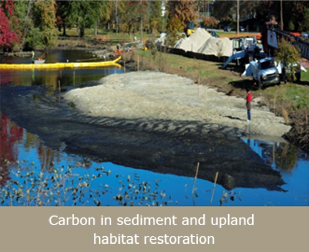|
Fish consumption advisories have been issued for the entire Saint Jones River, including Mirror Lake, for PCBs, dioxins, and mercury (DNREC, 2011). PCBs are thought to be the primary risk driver associated with consumption of fish. The average total PCB concentration in the surface sediments (0-2”) of Mirror Lake measured in 2004 was 144 ng/g dry weight (ppb dw), while the average in the subsurface sediments (>2”) was 478 ppb dw (Greene, 2011). PAHs are also high in Mirror Lake: the average total PAH concentration in the surface sediment of Mirror Lake is 45,800 ppb dw and the average in the subsurface sediments is 10,310 ppb dw (Cargill, 2010).
Modeling forecasts predicted 30 to 50 years of natural recover before the concentration of PCBs in Mirror Lake fish would decline to a level where an advisory will no longer be needed (Greene 2011). One of the primary factors that lead the DNREC to use carbon sequestration was to reduce that time horizon.
Treatability Studies
No specific treatability studies were done to determine the optimal rate of AC application at Mirror Lake. The dose of carbon delivered was determined by UMB based on previous work that demonstrated effectiveness at 5% dose of activated carbon to the top 10 cm of bioactive zone in sediments. With the addition of the activated carbon, a total effective carbon concentration of NNN% was the target goal. The basis for the project is provided in the attached Mirror Lake sequestration proposal (Click here to view sequestration proposal).
Engineering Specifications and Contracting
DNREC contracted with Biohabitats to draft the design plans and specifications and habitat restoration, and BrightFields Inc. to plan and manage the remediation and restoration activities. The complete engineering specifications and project plans have been placed on the internet by DNREC (Click here to view Mirror Lake Plan).
Placement Methods
A total of 158,381 pounds (~79 tons) of activated carbon as SediMite™ was used to cover the sediments in the lake and St. Jones River downstream channel. The material was spread from the bank of the lake using a telebelt, and from boats on the lake through the use of an induction air horn, Vortex spreaders, and by hand (click here to view figure). The videos listed above also show all four methods of application in action.
- The telebelt system consisted of a hopper and belt system and distributed approximately 80,000 lbs. of activated carbon over three days in rows over the east and west side of Mirror Lake. The telebelt system was also used to place sand that was used in the intertidal wetland restoration.
- An induction air horn using compressed air could distribute the active carbon with an approximate range of 15 feet to 20 feet. The induction air horns were used on land and in the boats to spread the material along the banks of the lake as well as in the areas which were not accessible with the telebelt (e,g. under overhanging trees). Transect lines and 20 foot by 20 foot grids were used to mark the application areas. Induction air horns were able to apply approximately 3-4 tons of product within an 8 hour work day.
- Vortex spreaders used gravity fed hoppers and a leaf blower to distribute the SediMite™ over an approximate range of 10 feet to 15 feet.
- Hand spreading was an efficient method of application but required more boat maneuvering to uniformly spread the SediMite™ over the entire area.
Post-treatment sampling indicates an average AC concentration of 4.3% by dry weight in surface sediments. While less than the initial goal of 5%, it was within an acceptable tolerance target of between 3-5% post application. To view the Mirror Lake Construction Completion Report, including the as-built drawings click here.
Performance Monitoring
The effectiveness of the AC treatment is being evaluated by monitoring bulk sediment, sediment porewater and surface water concentrations over time, as well as benthic invertebrate and fish tissue bioaccumulation. The initial (one year) post-construction monitoring showed over 60% reduction in dissolved PCBs in porewater and surface water, and a >55% reduction of PCB concentration in tissues of the resident fish species. As results become available those will be posted here.
Costs
The total project expenditures reported by the DNRC is approximately $1 million, which included planning, design, construction, and monitoring for 3 years. There was a significant contribution of hours from volunteers to the overall site restoration.
|



